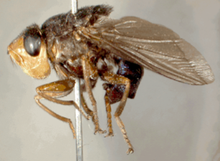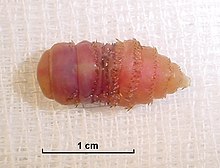 Oestridae are a family of flies variously known as bot flies, warble flies, heel flies, gadflies and similar names.
Oestridae are a family of flies variously known as bot flies, warble flies, heel flies, gadflies and similar names.Their larvae are internal parasites of mammals, some species growing in the host's flesh and others within the gut.
The human botfly, Dermatobia hominis, is the only species of bot fly known to parasitise humans routinely, though other species of fly do cause myiasis in humans.
Botflies deposit eggs on a host, or sometimes use an intermediate vector such as the common housefly, mosquitoes and even a species of tick.
The smaller fly is firmly held by the botfly female and rotated to a position where the botfly attaches some 30 eggs to the body under the wings.
Larvae from these eggs, stimulated by the warmth and proximity of a large mammal host, drop onto its skin and burrow underneath.
Eggs are deposited on animal skin directly, or the larvae hatch and drop from the eggs attached to the intermediate vector: the body heat of the host animal induces hatching upon contact or immediate proximity. Some forms of botfly also occur in the digestive tract after ingestion by licking.
Myiasis can be caused by larvae burrowing into the skin (or tissue lining) of the host animal.
Mature larvae drop from the host and complete the pupal stage in soil.
They do not kill the host animal, and thus are true parasites.
The developing on a horse
The equine bot fly presents seasonal difficulties to equestrian caretakers, as it lays eggs on the insides of horse's front legs, on the cannon bone and knees, and sometimes on the throat or nose, depending on the species of bot fly.
These eggs, which look like small, yellow drops of paint, must be carefully removed during the laying season to prevent infestation in the horse.
When a horse rubs its nose on its legs, the eggs are transferred to the mouth, and from there to the intestines, where the larvae grow and attach themselves to the stomach's lining or they pass into the small intestine and attach there.
 The attachment of the larvae to the tissue produces a mild irritation which results in erosions and ulcerations at this site.
The attachment of the larvae to the tissue produces a mild irritation which results in erosions and ulcerations at this site.Removal of the eggs (which adhere to the host's hair) is difficult, since the bone and tendons are directly under the skin on the cannon bones: eggs must be removed with a sharp knife or rough sand paper, and caught before they reach the ground.
The larvae remain attached and develop for 10–12 months before they are passed out in the feces. Occasionally horse owners will report seeing the bot fly larvae in horse manure.
These larvae are cylindrical in shape and are reddish orange in color. In 1–2 months adult bot flies will emerge from the developing larvae and the cycle will repeat
The human botfly
The human botfly occasionally uses humans as the host to its larvae.
The larva, because of its spines, can pose an extremely painful sub-epidermal condition.
Removal processes include placing raw meat on to the area, which in theory will coax the larva out.
Another option is to use the tree sap of the matatorsalo, found in Costa Rica, which is reputed to kill the larva, yet leave its body in the skin.
Additionally, one can attempt to seal the breathing hole of the larva with nail polish or vaseline and then, after a day, squeeze out the suffocated, dead larva.
Use of adhesive tape can work, but carries additional risk of infection because portions of the larva's breathing tube can be broken off by the tape and make the remainder of the body difficult to remove.
What is the truth?
Ally Vagg en Bryan William went through hell in there vacation in Bolivia as you can see in the above youtube video.
They thought they were dealing with infected mosquito bites until they felt something squirming under their skin.
When they saw something alive comming out there wounds, they realised they had big larvae in their bodies crawling around.
Vagg and Williams have been pulling seven maggots from wounds on their belly, back and legs.
Still, they have to stay there untill they are cured.
Like the Loa Loa there are so many flies that could ruin your body.
There are many horrors in cities, but maybe even more in the outdoor.
Oh wait... what is that on your face... A zit?




No comments:
Post a Comment